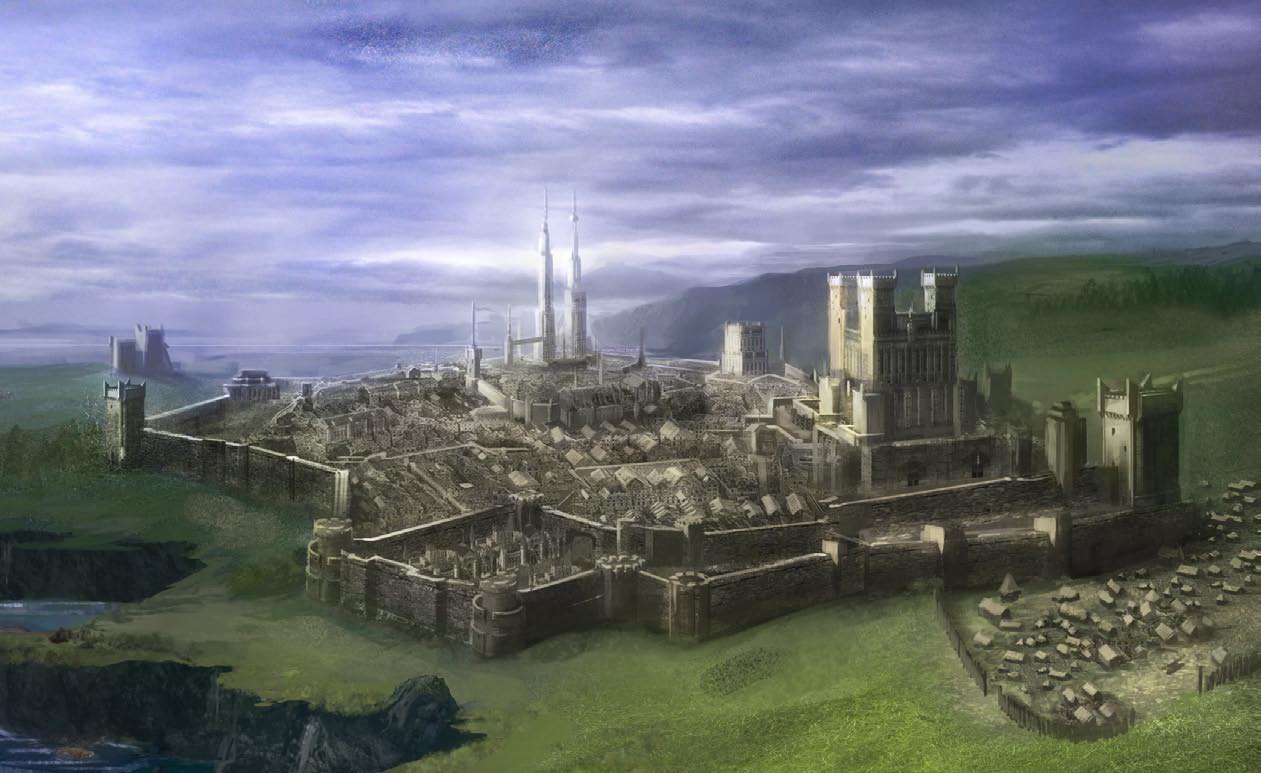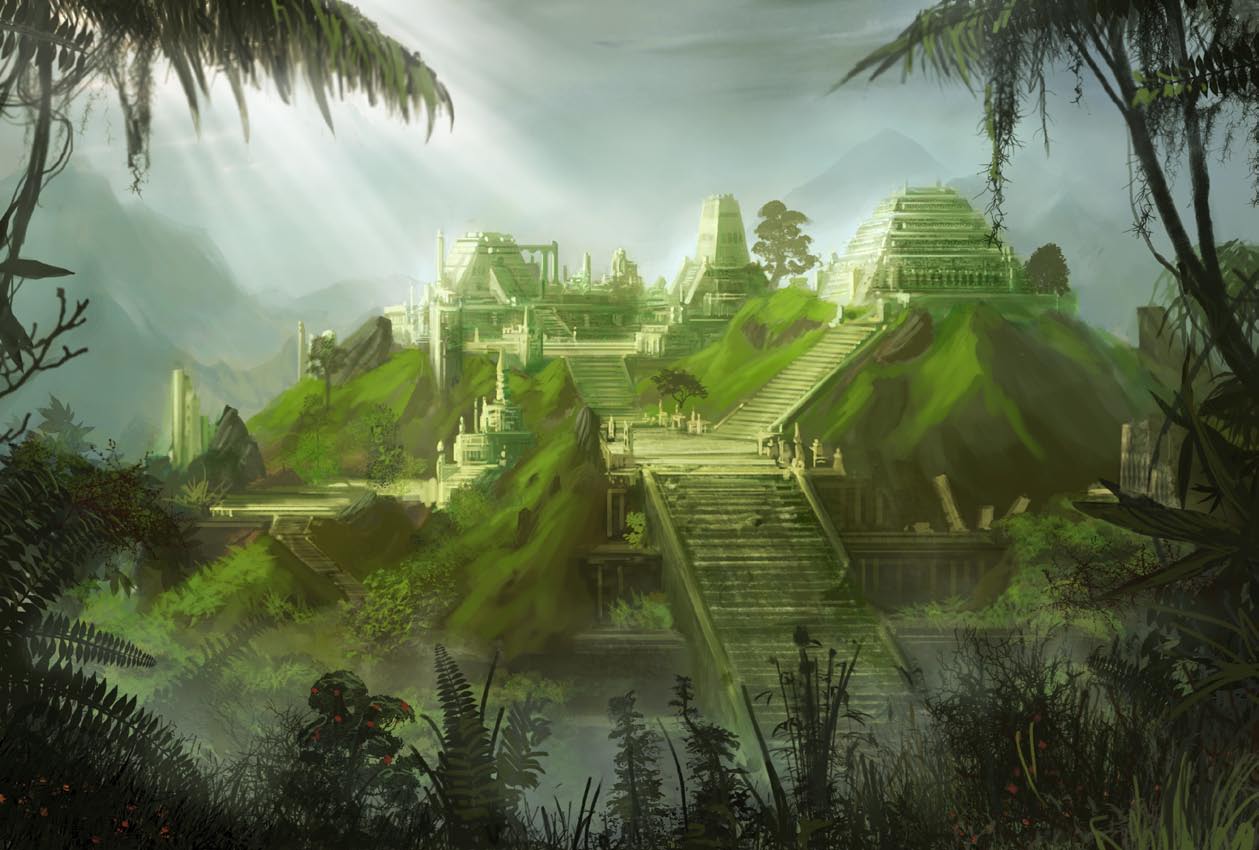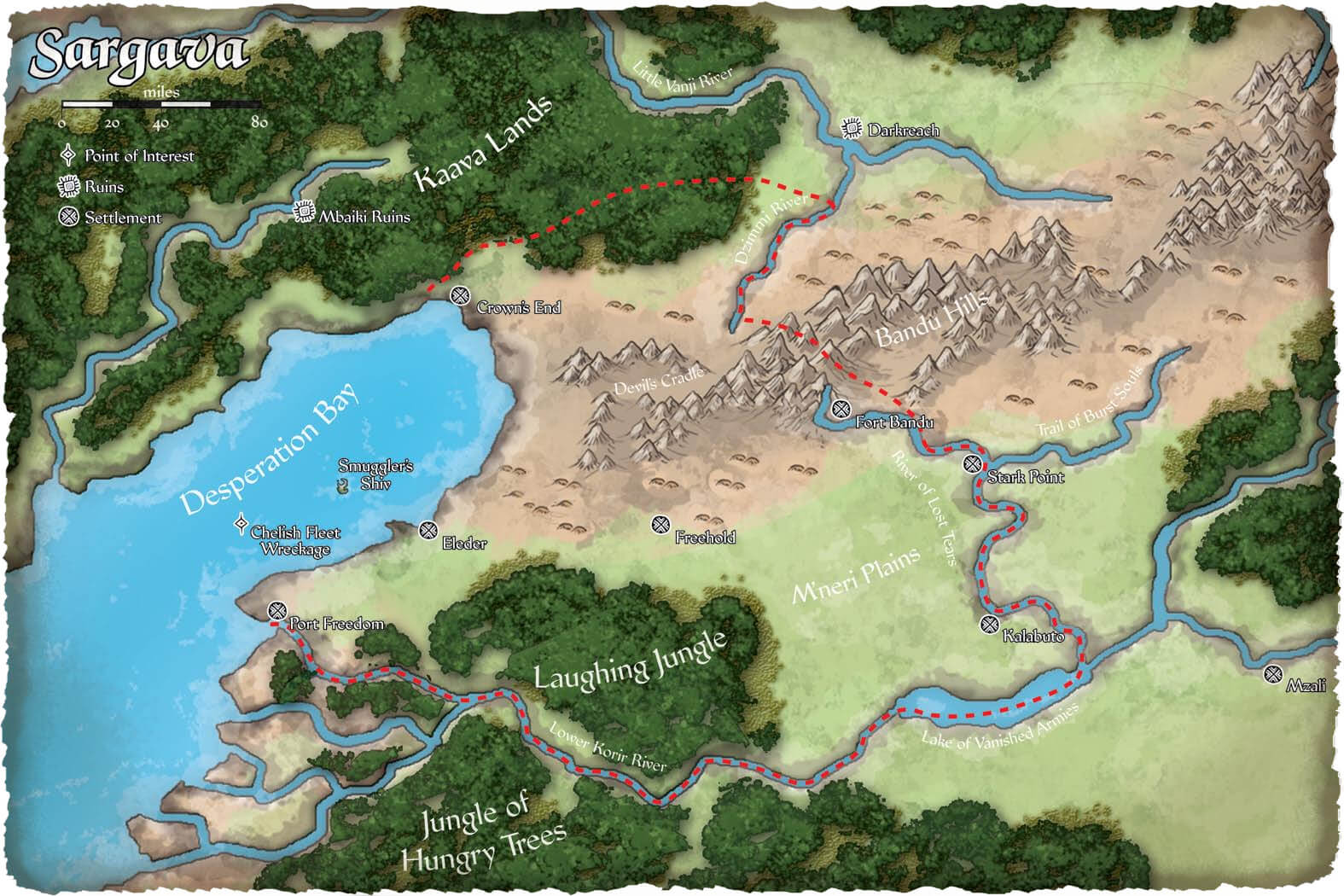“It’s a dangerous business, Frodo, going out your door. You step onto the road, and if you don’t keep your feet, there’s no knowing where you might be swept off to.”
Kadena AB Pathfinder Group

Days at Port: 33
Days at Sea: 71
Days on Smuggler’s Shiv: 30
Days in Eleder: 15
Days traveling to Kalabuto: 9
Total Journey: 158
How this works
“The jungles don’t recognize time. To them, every year is the same year: one of birth, and of death. The plants and beasts care little for the works of man, but those cities are there — oh yes, they’re there. Toppled spires of stone and stepped pyramids heavy with vines, their golden altars now roosts for chattering macaws. Inside, magnificent chambers stand empty, and those temples that aren’t abandoned are the worst yet—for the things that can survive a thousand years of silence are things best left undisturbed. The great cities, like their mysterious builders, have been forgotten. In time, they will be reclaimed completely by the jungle. As will we all, one day.”
— Shem Ervismor, Eyes in the Dark: My Life in the Expanse
Most things can be clicked to show/hide details
This site is meant as a resource for my players and is maintained directly and manually by the GM. This site is for use with the Serpents Skull adventure path.
If you're a player in this game and you haven't yet, visit the Character Creation tab to get started! Welcome to the adventure, and may Pharasma have mercy on your soul.
- Follow the tabs in the navigation bar to find:
- Home: Campaign and site details
- Character Creation: Details regarding how to create a character for this campaign.
- Discoveries: Details on information, magic items, and people encountered or recovered throughout the campaign.
- Explorers: Details regarding living and dead player characters, missions, campaign traits, and the strange powers or occurrences affecting them.
- Profiles: Details regarding all known allied, neutral, rival, enemy, or dead people and factions.
- Surveys: A record and map of locations visited, along with a review of the party's current location.
- Travel Log: A collection of discovered biographies and stories, and a running journal on the events of the adventure so-far.
- Jungle Law: Rules details for playing at the table, in this campaign, and in the jungle.
Campaign Details
- Click to Show/Hide Campaign and Character Details:
Knowledge Breakdown
- Click to Show/Hide Knowledge Uses:
The 10 Commandments of Tomb Raiding
- Click to Show/Hide information about Tomb Raiding:
Tribes of the Frontier
- Click to Show/Hide information about the native tribes:
Where We Are Now: Eleder

Appearance: Eleder is dominated by extensive stone docks, where ships from most nations on the Arcadian Ocean lie moored. The city is an unusual blend of architecture, as the gothic stonework of the colonists’ native Cheliax has adapted to the native building styles in favor of less stuffy, open designs that better combat the heat. Although Eleder itself is surrounded by a sturdy stone wall, the individual homes of many colonials also feature low stone walls and iron gates—a decorative concession to their roots that does nothing to make their homes less comfortable. These buildings are joined by more practical wood and canvas structures, and outside the city walls, countless mud-daub huts — the homes of the native workers — stretch far out into the banana, cocoa, and pineapple plantations.
History: The original founders of Sargava selected a small, natural harbor as the site of their future colony, gradually expanding from a stockaded encampment to a walled city with a fully equipped shipyard. It was named Eleder after the daughter of one of the original colonists, whose gentle diplomacy and efforts to learn Polyglot enabled the colonists to live in cooperation with the locals. Though the city today is named for Eleder’s efforts, the first several decades were fraught with violent misunderstandings between Chelaxians and natives. Large numbers of Chelish troops were brought in to help bring the native tribes under control, and they gradually convinced the tribes to assist the colonists in bringing “order” and industry to their “savage” land. When Sargava broke from Cheliax with the help of the Shackles, the citizens of Eleder opened up their repair yards as docks to ships of any nation, provided they paid a hefty fee for the privilege. Eleder is now considered one of the finest shipyards in Garund, and certainly the finest on the western coast. With the appointment of Utilinus to the position of Grand Custodian, Eleder has even made a few strides toward attracting other foreign businesses — mainly merchants from Nidal, Varisia, and Rahadoum. But though he has gained popularity with the colonials, the Grand Custodian is not well liked by the Hurricane King, who heavily taxes the merchant fleets his pirates guide past the Eye of Abendego.
Society: Eleder is a city of contradictions. The colonials live in relative luxury, while the native workers dwell in poverty outside the city walls. While countless scruffy sailors and explorers parade through Eleder every year en route to adventures in the interior — or simply on their way to enjoy the brothels and clubs Eleder maintains near the docks to keep pirates out of the city proper — the colonials maintain high personal standards of decorum and propriety. Although Grand Custodian Utilinus is Sargava’s authority, the elderly Lady Madrona Daugustana is the city’s unofficial leader. As the oldest living colonial in all of Sargava, Lady Madrona bears the responsibility of upholding the ideals and customs of her forebearers, and any major undertaking must meet her approval.While the majority of colonials consider the native Mwangi to be a “lesser people” than themselves, they rely on them not only as a labor pool but as a standing militia of poorly paid volunteers. Eleder’s Praetor, Commander Ezio Egorius, regularly drills the Sargavan Guard, which consists of mixed units, though all Mwangi natives are enlisted regulars while the colonials are all officers, much to the ire of many Mwangi veterans.
Adventurers: Though Sargava relies on the influx of foreign money to pay its debts to the Shackles pirates, the Eleder colonials would much rather the seemingly constant stream of adventurers and explorers sail up the Korir River to their destinations incountry, bypassing Eleder completely. In the words of Lady Madrona Daugustana, “Adventurers merely pass through Eleder; we must live here when they are long gone.”The major problem most colonials have with adventurers is that the colonials are barely keeping the Mwangi populace under control as it as, and in their view, the last thing they need is thrill-seekers or would-be “liberators” stirring up the natives, either by picking fights with tribal warriors or speaking ill of the colonials to the workers.Adding to the problem, adventurers rarely bother to learn the local customs, let alone observe the agreements between the tribes and the colonials, and a single incident can sour an entire tribe against all foreigners.Finally, the people of Eleder are obsessed with dignity and decorum — going even beyond many northern countries in their attempts to prove that they’ve remained “civilized” — and consider the carousing of bored adventurers the height of impropriety. It is bad enough for dwarves to stagger through the streets singing after dark, but having one’s daughter indecently solicited by an Ulfen barbarian quickly alienates even the most open-minded Sargavan colonist.
Destination: Kalabuto

From a distance, Kalabuto seems to be nothing more than a low hill surrounded by fields of pineapples, with a few scattered buildings under a pall of smoke. This is because the city ruins are almost entirely covered with centuries of jungle growth. Closer up, visitors quickly notice the thousands of native Mwangi coming and going from the city in the hustle and bustle of commerce and daily life. For many, it’s not until they approach quite close to the city gates that they realize the hill is actually a collection of crumbling stone buildings covered in tangled vines and other greenery.
As it stands, the city appears to be overgrown by the jungle, with a large collection of shanties and warehouses along the riverbank. Kalabuto is a center of trade with the Mwangi interior, serving as a trade hub between foreign colonials, foreigners, and indigenous tribespeople. Over the years, overland caravans have declined in favor of more efficient river barges. To accommodate the increase in vessels, the city erected a snaking boardwalk connected to an elaborate tangle of docks. Warehouses make up the bulk of the structures along the water’s edge. Further inland, the ruins of the original ancient city begin, climbing up the hill to the more lavish private colonial residences.
While native Kalabuta-Vidric inhabit the majority of the city’s ruins, a small minority of Sargavan colonials rule the city and have claimed the highest buildings with the best views for themselves. Racial tension is thus rife in Kalabuto. But the city also serves as Sargava’s first line of defense against the city-state of Mzali. In this role Kalabuto has suffered greatly, and has been sacked by the Mzali forces on several occasions.
Not just the most populous city in Sargava, Kalabuto sits on the edge of the expansive jungle; the last bastion of civilization before the wilderness. In contrast to Eleder, explorers and adventurers find that Kalabuto awaits them with open arms. . Those who do not find work as soldiers in the Kalabuto militia usually find plenty of opportunities with expeditions setting out to explore the Bandu Hills, Mzali, and the Screaming Jungle; the colonials look forward to sending new adventurers on the dangerous missions the local Mwangi refuse to undertake, while the natives readily hire themselves out to adventurers, who often treat and pay them better than the colonials.
Sargava at a Glance

Beset by devil-binding pilgrims and inescapable debts to pirate lords, as well as generations of resentment from the nation’s subjugated indigenous peoples, the colony of Sargava remains a bastion of northern culture and civilization in the heart of the southern wilds. Once part of a vast and mighty empire long since fallen to dust, as evidenced by the crumbling ruins still lurking beneath the veneer of lush farmland and verdant jungle, Sargava’s rich landscape is home to fierce Mwangi natives and even fiercer predators of the deep jungle, as well as a dwindling population of northern colonials who seek to uphold their ideals of culture and breeding at all cost, straining against the tides of resentment that may soon sweep them into the sea and return the land to its original owners.
Founded over 500 years ago by Prince Haliad I as part of Cheliax’s expansionist Everwar, Sargava stood as the jewel of the empire for centuries. But when Aroden died, the empire was thrown into chaos, and Sargava’s ruler backed the wrong house in the Chelish Civil War. House Thrune took control of Cheliax and sent a flotilla of warships to retake the colony that had supported their enemy in the bloody conflict. Grand Custodian Grallus anticipated the onslaught, however, and made a fateful alliance with the Free Captains of the Shackles. Swooping out of Desperation Bay to pounce on the unsuspecting Chelish Navy, the pirates’ superior fleet swiftly ended the threat to their southern neighbor, and extracted a mighty price from Sargava for their efforts. To this day, vast portions of Sargava’s wealth flow into the Free Captains’ coffers for past assistance and assurance of continued naval protection.
Financially weakened by the Free Captains’ high demands and cut off from many of their former trade partners to the north, Sargava faces an even larger threat from within. The native Mwangi people, inspired by the teachings of a mysterious, undead child-god in the nearby city-state of Mzali, move ever closer to open rebellion to free themselves from colonial rule. While Cheliax no longer has an official stake in Sargava’s government, the colonial Sargavan minority maintains control of the vastly larger native population. But the natives know that they have the resources of the entire Mwangi Expanse at their backs, and that Grand Custodian Utilinus’s government is in a poor position to quell a rebellion.
